- Author Jason Gerald [email protected].
- Public 2023-12-16 10:50.
- Last modified 2025-01-23 12:04.
Footnotes are commonly used in academic and professional writing to cite sources or include additional information in the main article. Academic citation methods such as the Modern Language Association (MLA) and the American Psychological Association (APA) discourage excessive use of footnotes, but other methods, such as the Chicago style, do.
Step
Method 1 of 3: Formatting Footnotes
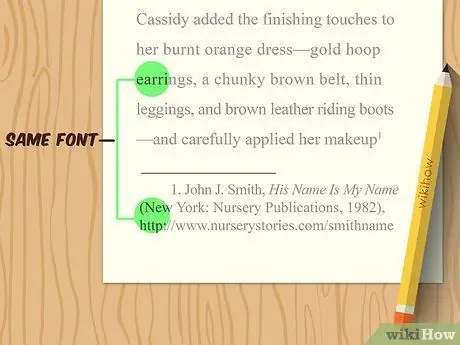
Step 1. Use the same font as the rest of the text
In general, the font used for footnotes should match the body of the text. Word processor default fonts are usually good.
Tip:
Usual footnote font size smaller than the main text. There is no need to change the default size of the word processor, it is already automatic when you create a footnote.

Step 2. Place the footnote number after the closing punctuation mark
Usually, footnotes are placed at the end of sentences whose information you need to quote or discuss. Some methods provide a number that aligns with the text after the closing punctuation mark, followed by a period. Another method uses superscript numbers.
A sentence usually has only one footnote. If you need more than one footnote, place the other footnote at the end of the corresponding sentence clause, outside of the closing punctuation mark. The only exception is when the sentence is broken by a dash, and in this case, the superscript number is put before the dash
Number of Footnotes Aligned with Text:
It is known that patients with Crohn's and Colitis experience many symptoms of weakness. 1.
Superscript Footnote Numbers:
It is known that patients with Crohn's and Colitis experience many symptoms of weakness.1

Step 3. Use consecutive numbers throughout the paper
Footnotes start from "1" and continue until the end of the paper. The numbering is not repeated on a new page. Each footnote has its own number even though it cites the same source as the previous footnote.
- For long papers, such as doctoral theses, the number of footnotes can be restarted with each chapter. If you're not sure, discuss it with your editor or supervisor.
- Most word processor programs implement sequential numbers, as long as you use the built-in footnote insertion function instead of typing the numbers manually.
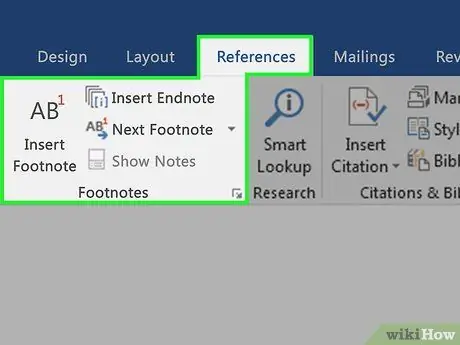
Step 4. Insert the footnote using a word processor program
Most word processor programs already provide a function that can easily insert footnotes into a paper. This function is usually in "Insert" or "Reference" in the menu bar.
Usually formatting options are also provided so you can choose numbers, letters, or other symbols to indicate footnotes. You can also change the size or placement of the footer although the default options are usually correct
Method 2 of 3: Placing References in Footnotes
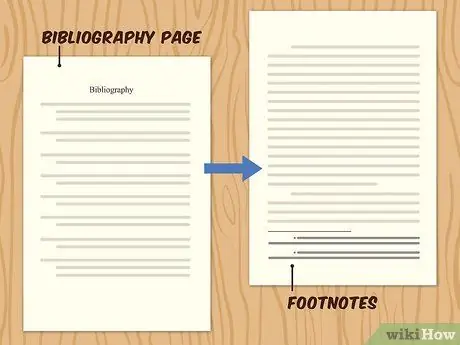
Step 1. Write a bibliography page before placing footnotes
References in footnotes are usually abbreviated versions of the bibliography or bibliography at the end of the paper. By creating a bibliography in advance, it will be easier for you to create footnotes and ensure that all sources are included.
In most citation methods, the use of footnotes does not replace the need for a bibliography at the end of the paper. Although not required, a bibliography will help give context to the paper

Step 2. Write a reference according to the guide of the method you choose
Although the basic reference information is almost always the same, the formats used vary. In general, you should include the author's name first, followed by the title of the article. Enter publication information, then end with a page containing the material you extracted or quoted.
Let's say you quote information from a book written by Reginald Daily, entitled Timeless wikiHow Examples: Through the Ages. If you're using the Chicago method, the footnote looks like this: Reginald Daily, Timeless wikiHow Examples: Through the Ages (Minneapolis: St. Olaf Press, 2010), 115
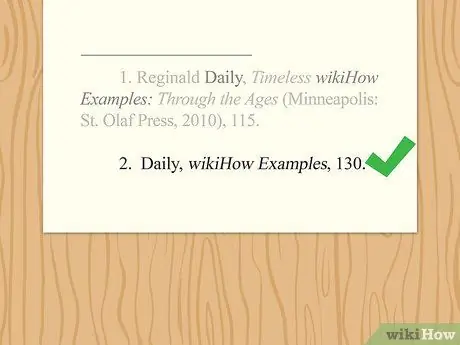
Step 3. Use brief references for successive uses of the same source
Usually, you will cite the same source more than once. You only need to write a complete reference once. Subsequent references include only the author's last name, the title of the abbreviated version, and the page containing the material you quoted.
For example, you should quote Reginald Daily's book on wikiHow again. The abbreviated version of the reference goes like this: Daily, wikiHow Examples, 130
Tip:
Some citation methods suggest using abbreviations "id." or "ibid." if you cite the same source consecutively. Other methods, such as the Chicago Manual of Style, require the use of brief references.
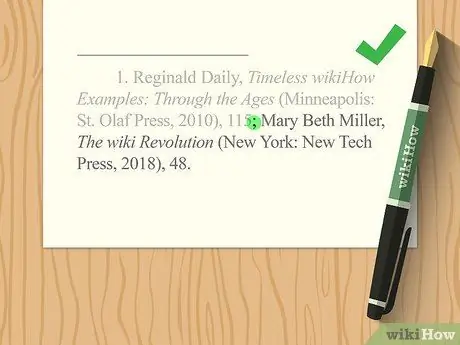
Step 4. Separate multiple references with a semicolon
Sometimes, a sentence cites more than one source. Place one footnote at the end of the sentence and include references to both sources in the same footnote, not two footnotes at the end of the sentence.
Say there is a sentence in your paper that compares the conclusions in Reginald Daily's book with observations in other books on the same topic. The footnotes might look like this: Reginald Daily, Timeless wikiHow Examples: Through the Ages (Minneapolis: St. Olaf Press, 2010), 115; Mary Beth Miller, The wiki Revolution (New York: New Tech Press, 2018), 48

Step 5. Enter a clue phrase to explain the relationship between multiple sources
Hint words and phrases, such as "but look" or "see also" let readers know that other authors agree or disagree with the information in the original source you cited. Usually, you need to use additional sources to confirm the relative reliability of the sources you cite.
- For example, if Miller's writing reached a conclusion that contradicted the Daily's, your footnote could be something like this: Timeless wikiHow Examples: Through the Ages (Minneapolis: St. Olaf Press, 2010), 115; but see Mary Beth Miller, The wiki Revolution (New York: New Tech Press, 2018), 48.
- If you think it will help the reader, add a short comment after the second source, explaining why you included it.
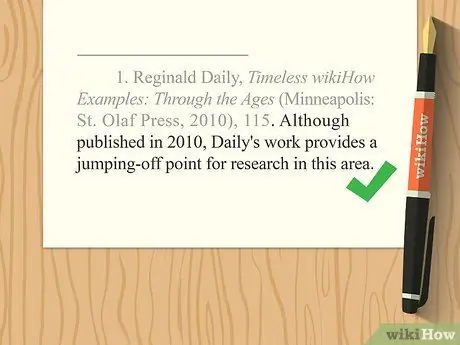
Step 6. Add contextual information if needed
Reference footnotes usually contain references only. However, sometimes you have to explain something about the source or how it relates to your paper.
Say you want to include a brief explanation of the reasons for citing the Daily book even though it was published in 2010. Your footnote could be something like this: Reginald Daily, Timeless wikiHow Examples: Through the Ages (Minneapolis: St. Olaf Press, 2010), 115. Even if published in 2010, the Daily article provides a starting point for research in this area
Method 3 of 3: Completing the Main Text

Step 1. Include the bibliography in the MLA paper
The MLA method does not recommend the general use of footnotes. However, footnotes are allowed to refer readers to other publications that cover the topic more thoroughly.
- For example, there are basic concepts that are beyond the scope of your paper, but are important for readers to understand. You can add a footnote that says, "For an explanation of the theory of relativity, see" followed by a source or list of sources.
- Usually, this type of footnote provides information about something that is not directly related to the paper, but is important to help readers understand the topic as a whole or provide context for your paper.

Step 2. Use footnotes to include additional information that doesn't fit into the flow of the writing
Unrelated comments or insertions can disrupt the flow of writing and potentially confuse readers. If you want to write additional comments, include them in footnotes so that the reader's attention is not distracted from the main point of the paper.
Some methods, such as MLA and APA, instruct that additional statements should be included in the main text of the paper, not in footnotes
Tip:
Keep footnotes as short as possible, especially those with additional information. Don't go too far from the topic or discuss something that is not really related to the topic of the paper.

Step 3. Provide a definition, explanation, or clarification
Sometimes, you have to provide additional information so that the reader understands the intent of the source. You also need to explain the significance of something mentioned in a non-public knowledge source.
This type of footnote often accompanies citations from sources and may include references. For example, if you're citing a source discussing wikiHow, and want clarification, add a footnote that says, "wikiHow examples are used to clarify text in situations that would be most helpful with visual clues. Reginald Daily, Timeless wikiHow Examples: Through the Ages (Minneapolis: St. Olaf Press, 2010), 115."

Step 4. Provide additional citations or comments to add depth to the paper
Sometimes, sources include citations that you find interesting, but cannot be included in the main text. There may also be information in the text that you would like to comment on, but that is outside the scope of the paper.
- Let's say you're writing a paper about using wikiHow articles as sources, and you include a study finding that wikiHow articles are more accurate than articles on a major news site on a similar topic. You could add a footnote that says, "Despite this fact, the majority of professors at public universities do not accept wikiHow articles as a research paper resource."
- You can also use footnotes to include witty and witty comments that can add humor and lightness to the paper. However, such use is rare, and only when appropriate and on-topic.
Tips
- Before writing, confirm with the lecturer or organization about what citation method should be used. Make sure your footnotes follow the rules of the method.
- If the footnote includes a reference as well as additional information, the reference is usually listed first.






